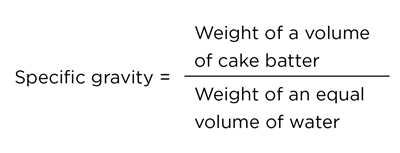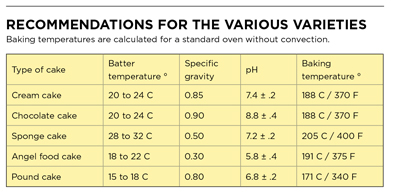
Tricks of the Trade: October 2011
September 20, 2011
By
FORMA-LAB
Missing volume in your cake?
Missing volume in your cake? There are many causes that can lead to a lack of volume in cakes, and many depend on the type of cake being prepared. Here are the definitions of the various types of cakes (the flavour doesn’t matter):
- Cream cake made with shortening or rich in oil, mixed with a paddle in three stages;
- Sponge, Genoese or angel food cake made without fat or with an emulsifier, mixed with the whip in one or two stages;
- Pound cake rich in eggs and butter, mixed in three stages. This cake is very heavy, has less volume, and features a dense and compact crumb, which gives it a long shelf life. This is the type of cake batter used for fruitcakes; and
- Cheesecake made with cream or cottage cheese. Lack of volume is not a concern with this type of cake.
There are 10 major issues that can lead to a lack of volume in your cakes. They are:
- Poorly formulated recipe or inaccurate conversions;
- Inadequate mixing;
- Batter that is too thick, with an insufficient quantity of water;
- Temperature of the batter too cold or too warm (see sidebar);
- Eggs that are too old eggs, or a lack of egg solids;
- Insufficient baking powder in the batter, or using the wrong type of leavening agent in the batter;
- Too much rest time between mixing and baking;
- Not enough batter for the size of the cake pan;
- Oven temperature too high during baking (see sidebar);
- Too much vapour in the oven.
Another common problem is cakes falling during baking. Common causes include:
- Too much leavening agent, causing the cake to collapse in the centre;
- Too much air incorporated during mixing or too much emulsifier (see specific gravity calculation);
- Poor quality of egg solids;
- Flour that is too weak;
- Abrupt movements during baking, which may cause the rack or tablet to vibrate;
- Oven temperature too low during baking (see sidebar).
Cakes may also shrink during baking due to:
- Too much leavening agent in the batter;
- Too much water or liquid in the batter;
- Flour that is too strong;
- Batter that is too cold or an oven heated to too high a temperature (see sidebar).
The best way to guarantee a quality cake with an accurate volume is to consider the following criteria:
- Final batter temperature (see sidebar);
- The specific gravity of the cake batter. The specific gravity is the measure of air incorporated into cake batter during mixing. The incorporated air determines the texture, final volume and symmetry of the cake. The specific gravity is obtained by dividing the weight of the batter by volume into the weight of the same volume of water. The specific gravity is not a weight but a fraction relative to the same volume of water, which has a value of 1.00
 |
- The pH of the batter. The pH influences the optimal volume, the grain and the texture of a cake. A higher pH will give more volume but it will also result in an open crumb. A lower pH will reduce volume and produce a fine crumb (see sidebar).
- Baking temperature. The temperature of baking is variable according to the type of oven, which is different for every bakery. Baking temperature in a convection oven will be 30 C (50 F) less than in other types of ovens.

|
Mario Fortin is an international bakery consultant and owner of FORMA-LAB, a consulting service for bakers and suppliers. If you have a technical problem, send your questions to info@forma-lab.com.
Print this page
Leave a Reply